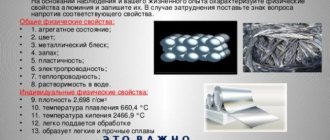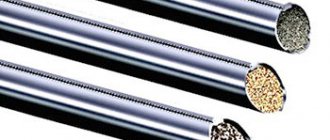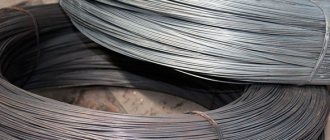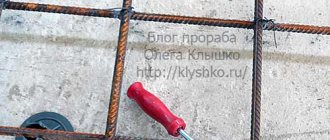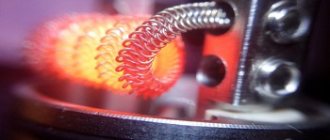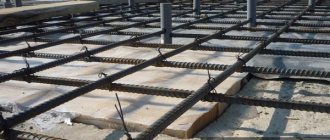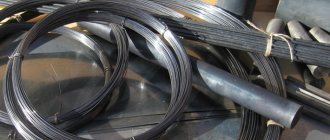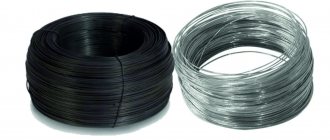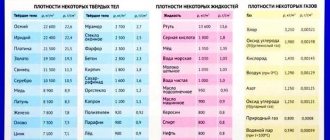Wire rod is a type of rolled metal product, which is a round wire made from carbon steel grades St0, St1, St2 and St3, in accordance with GOST 380, or from non-ferrous metals or alloys of non-ferrous metals in accordance with the accepted specifications. Carbon steel wire rod is available in diameter 5.0; 5.5; 6.0; 6.3; 6.5; 7.0; 8.0 and 9.0 mm. In this case, deviations in diameter are allowed +/- 5%, and the ovality of the wire rod is allowed no more than 50% of its diameter. Wire rods made of non-ferrous metals (copper, aluminum) or their alloys (bronze, brass) are manufactured with a diameter of 1 to 16 mm. Wire with large diameters is made to order in limited quantities. Wire and wire rod are two words denoting the same material.
Normative references
This standard uses normative references to the following standards:
GOST R 8.563-96 State system for ensuring the uniformity of measurements. Methods for performing measurements GOST R 53228—2008 Non-automatic scales. Part 1. Metrological and technical requirements. Tests GOST 15.309-98 System for development and production of products. Testing and acceptance of manufactured products. Basic provisions of GOST 859-2001 Copper. Grades GOST 1012—72 Aviation gasoline. Technical specifications GOST 1497-84 (ISO 6892-84) Metals. Tensile test methods GOST 1545-80 Wire. Torsion test method GOST 2768-84 Technical acetone. Technical specifications GOST 4204-77 Reagents. Sulfuric acid. Technical specifications GOST 4381-87 Lever micrometers. General technical conditions GOST 6507-90 Micrometers. Technical specifications GOST 7229-76 Cables. wires and cords. Method for determining the electrical resistance of current-carrying cores and conductors GOST 9717.2-82 Copper. Method of spectral analysis using metal standard samples with photographic recording of the spectrum GOST 9717.3-82 Copper. Method of spectral analysis for oxide standard samples GOST 13938.11-78 Copper. - Method for determining arsenic GOST 13938.13-93 Copper. - Methods for determining oxygen GOST 15150-69 Machines, instruments and other technical products. Versions for different climatic regions. Categories, conditions of operation, storage and transportation regarding the impact of climatic factors of the external environment GOST 18690-82 Cables, wires, cords and cable fittings. Labeling, packaging, transportation and storage GOST 24047-80 Semi-finished products from non-ferrous metals and their alloys. Sampling for tensile testing GOST 24048-80 (ISO 2626-73) Copper. Methods for determining resistance to hydrogen embrittlement GOST 24104—2001 Laboratory balances. General technical requirements GOST 24231-80 Non-ferrous metals and alloys. General requirements for the selection and preparation of samples for chemical analysis GOST 26877-91 Metal products. Methods for measuring shape deviations GOST 27981.1-88 High purity copper. Methods of atomic spectral analysis GOST 27981.2-88 High purity copper. Method of chemical atomic emission analysis GOST 27981.5-88 High purity copper. Photometric methods of analysis GOST 281 06-89 Copper cathodes. Selection and preparation of samples and specimens for determining electrical resistivity GOST 28498-90 Liquid glass thermometers. General technical requirements. Test methods GOST 2851 5-97 Copper. Method for testing samples for spiral elongation GOST 29329-92* Scales for static weighing. General technical requirements GOST 31382—2009 Copper. Methods of analysis ST SEV 543-77 Numbers. Recording and rounding rules
* GOST R 53228-2008 is in force on the territory of the Russian Federation: from 01/01/2010 - in terms of newly developed and modernized scales: from 01/01/2013 - in terms of scales developed before 01/01/2010.
Note - When using this standard, it is advisable to check the validity of the reference standards in the public information system - on the official website of the Federal Agency for Technical Regulation and Metrology on the Internet or using the annually published information index “National Standards”, which was published as of January 1 of the current year , and according to the corresponding monthly information indexes published in the current year. If the reference standard is replaced (changed), then when using this standard you should be guided by the replacing (changed) standard. If the reference standard is canceled without replacement, then the provision in which a reference is made to it is applied in the part that does not affect this reference.
World market of copper rod, price dynamics, exporters and importers of copper rod.
It should be noted that there are not many major players in this field. Copper rod imports are carried out by countries such as China - its share in global imports of copper rod is over 14%, followed by the USA and Germany with percentage shares of about 7 and 6%, respectively. After these three leaders in the purchase of copper wire rod are countries with an insignificant percentage, but in total they gain about 60 - these are the countries of old Europe Germany, France, the Czech Republic, Switzerland, Italy, then India, Great Britain. Russia has increased imports of copper wire rod since 2010, but this share is insignificant. It would seem strange, but among the exporters there are practically the same people, the leader in sales is Germany with a 9% share, Russia, Belgium, Korea and the USA each occupy 5% of the market, little by little Poland, Slovakia, Italy and France sell copper wire rod.
Despite the catastrophic decline in prices and very modest forecasts for their growth from leading exchanges, incl. and from the London Stock Exchange - in quantitative terms, the consumption and sale of wire rod does not change much. The fall in prices for all non-ferrous metallurgy has been ongoing since March, a sharp decline occurred in June, at the moment there is a slight increase and revival of the market, but the previous price level is still a long way off. Perhaps the fall in prices is also due to the weakening of the domestic currencies of the main selling countries, perhaps with a global freeze in production, it is also possible that high prices were maintained artificially, it is no secret that sometimes unnecessary reserves are created, which are then dumped. Of course, one can guess for a long time and there will be some truth in every assumption. Experts, however, believe that the main reasons for the fall in prices are the internal crisis of the PRC - and this is the main buyer, where economic growth rates have seriously fallen, and as soon as the situation stabilizes, the market will revive. The second reason for the fall in prices is considered to be the expected tightening of US monetary policy; as soon as it became clear that this forecast was delayed in time, the situation also moved towards stability. The third reason is the presence of surpluses on world exchanges, and the fourth reason can be considered a decrease in the deficit of copper and an increase in its production by 1.39% and refined copper by 7.99%. Among the analysts surveyed by Reuters, the general opinion is that in 2015, the excess of copper on the world market will be 221 thousand tons, in general, the situation is not frightening, compared to the crisis of 2008, this time a recovery in prices is expected by 2016.
Terms and Definitions
The following terms with corresponding definitions are used in this standard:
3.1 wire rod: A billet with a transverse circular cross-section, constant along its entire length, rolled into a coil, produced, as a rule, by the continuous casting method or by the method of continuous casting and rolling.
3.2 ovality (deviation from roundness): Half the difference between the largest and smallest diameters measured in one cross section perpendicular to the axis of the wire rod.
3.3 coil: A length of product wound in a series of continuous turns.
Wire rod GOST 30136 - useful information
Steel wire rod is used for further processing - re-tensioning into wire, as well as for other purposes, for example, for the manufacture of hardware products - fasteners (staples, etc.), meshes. Without processing, it can be used as a binding material for finished rolled metal.
How much does a coil of wire rod weigh approximately 6.5
6.5 mm wire rod can be supplied in coils weighing at least 160 kg, in coils of different weights - from 700 to 2000 kg or more (up to 2.5 tons) or from 1200 to 1450 kg (depending on the production capacity of different manufacturers).
Do you have galvanized wire rod for sale?
Yes, sometimes. Galvanized wire rod is widely used in construction and in lightning protection systems. From us you can buy carbon wire rod and use the services of galvanizing its surface.
What is the manufacturing technology of wire rod 30165-95
Wire rod refers to hot-rolled bars and is produced with normal or increased rolling precision on modern high-speed wire or bar mills equipped with cooling lines. Thanks to accelerated cooling technologies during the rolling process (UO2, UO1 or VO), in which the rolling speed increases and the cooling modes are regulated in a certain speed range, the finished rolled product acquires the specified structure and properties.
As a result of CO2 or two-stage accelerated cooling (water - between the rolling mill stands and intensive air - at the stage of coil formation) this product is obtained:
- with a fine pearlite structure (with the absence of martensitic and troostomartensitic sections)
- with a well-formed surface, on which there can be no more than 10 kg/t scale
- having good ductile properties (the finished rolled product must withstand bending 180º around a mandrel with a diameter equal to the diameter of the wire rod sample)
- with normalized temporary resistance no more than N/sq. mm: 540 - for St3 of all degrees of deoxidation, 470N/sq. mm - for St0, as well as St1 and St2 of all degrees of deoxidation
Main parameters and dimensions
4.1 Wire rods are produced by the following brands:
- KM - copper wire rod;
- KMB - oxygen-free copper wire rod:
- KMor is a copper wire rod produced by continuous casting and rolling from refined waste and copper scrap.
4.2 The nominal diameter of the wire rod and the maximum deviation from the nominal diameter must correspond to those indicated in Table 1.
Table 1. In millimeters
| Nominal wire rod diameter | Maximum deviation from the nominal diameter | Nominal wire rod diameter | Maximum deviation from the nominal diameter |
| 8.0 9.5 10.0 11.4 12.7 13.0 14.0 | ± 0.4 | 16.0 18.0 22.0 23.0 | ± 0.6 |
Note - By agreement between the consumer and the manufacturer, wire rod with a nominal diameter of 8.0 mm can be manufactured with a maximum deviation from the nominal diameter of ± 0.3 mm. It is possible to manufacture wire rod of other diameters, but the maximum deviation from the diameter must correspond to the nearest larger size indicated in this table
4.3 The ovality of the wire rod should not exceed the maximum deviation from the diameter.
4.4 The symbol for wire rod must include:
- brand of wire rod,
- symbol of the grade of copper from which the wire rod is made (5.3.1)
- nominal wire rod diameter,
- designation of this standard.
An example of a symbol for wire rod of the KM brand. made of copper grade M001, diameter 8.0 mm:
Wire rod KM M001 8.0 GOST R 53803-2010
Wire rod price. Wire rod weight.
The cost of wire rod is comparable to the cost of the material from which it is made. For example, steel wire rod can cost 20-30 rubles per kg, aluminum wire rod costs about 150 rubles per kilogram, copper wire - about 300 rubles per kilogram.
Wire rod weight: weight of one meter depending on the diameter and length of one ton depending on the diameter
The weight of the wire rod depends on its material and diameter. As an example, the table shows the weight of steel rod depending on the diameter. Copper wire has about the same weight. Aluminum wire is approximately three times lighter than steel and copper.
Technical requirements
5.1 General requirements
Wire rod is manufactured in accordance with the requirements of this standard according to technological documentation approved in the prescribed manner.
The wire rod must be made of copper of such quality and purity that it provides the properties and characteristics of the wire rod established by this standard and allows the wire rod to be used for its intended purpose.
5.2 Characteristics
5.2.1 Surface quality requirements
5.2.1.1 The wire rod along its entire length must have a clean and smooth surface.
Holes, scratches, dents, nicks and other surface defects are allowed on the surface of the wire rod, the depth of which does not exceed 0.2 mm during control cleaning. Allowed defects should not prevent further processing of the wire rod.
5.2.1.2 On the surface of wire rod grades KM and KMor with a diameter of up to 18.0 mm inclusive, surface oxidation (oxide film thickness) is allowed: no more than 1 • 10-7 m (1000 A*) - with the electrochemical measurement method or no more than 0.01% - using the weight measurement method.
The surface oxidation of KMB grade wire rod of all diameters and KM and KMor grade wire rod with a diameter over 18.0 mm is not standardized.
By agreement between the consumer and the manufacturer, it is allowed to produce KM brand wire rod with surface oxidation: no more than 0.5 • 10-7 m (500 A*) - with the electrochemical method of measurement or no more than 0.005% - with the gravimetric method of measurement.
A - Angstrom.
5.3 Chemical composition requirements
5.3.1 KM grade wire rod in chemical composition must correspond to M001 grade copper. M0, wire rod grade KMB - copper grades M001b, M0b: wire rod grade KMor - copper grade M1or.
5.3.2 Chemical composition of copper grades MO, M0b according to GOST 859 and grades M001, M001b. M1or according to this standard must correspond to that specified in Table 2.
table 2
| Element | Mass fraction, %, no more. for copper grades | |||||
| M001 | MO | M001b | M0b | M1or | ||
| Impurities by group: | ||||||
| 1 | Bismuth Selenium Tellurium Sum 1st group | 0.0002 0.0002 0.0002 0.0003 | 0.0005 — — — | 0.0002 0.0002 0.0002 0,0003 | 0.001 — — — | — — — — |
| 2 | Chromium Manganese Antimony Cadmium Arsenic Phosphorus Amount of the 2nd group | — — 0.0004 — 0.0005 — 0.0015 | — — 0.002 — 0.001 — — | — — 0.0004 — 0.0005 — 0.0015 | — — 0.002 — 0.002 0.002 — | — — — — — — — |
| 3 | Lead | 0.0005 | 0,003 | 0,0005 | 0.003 | — |
| 4 | Sulfur | 0.0015 | 0,003 | 0,0015 | 0.003 | — |
| 5 | Tin Nickel Iron Silicon Zinc Cobalt Group 5 Amount | — — 0.001 — — — 0,002 | 0.001 0.002 0,004 — 0.003 — — | — — 0.001 — — — 0.002 | 0.002 0,002 0.004 — 0.003 — — | — — — — — — — |
| 6 | Silver | 0.0025 | — | 0,0023 | — | — |
| Sum of listed impurities | 0.0065 | — | 0.0065 | — | 0.065 | |
| Oxygen | 0,04 | 0.04 | 0.001 | 0.001 | 0.025 | |
Notes: 1 - The mass fraction of copper for copper grades M001, M001b is determined by subtracting the sum of the mass fractions of impurities from 100%. Mass fraction (copper + silver) for copper grades: MO - no less than 99.93%; M0b - no less than 99.97%; M1or - no less than 99.91%. 2 — It is allowed to manufacture wire rod from copper grades with a mass fraction of oxygen. M001, MO, M1or - no more than 0.065; M001b, M0b - no more than 0.002%. 3 — The “-” sign means that the element is not standardized.
5.4 Electrical requirements
5.4.1 Electrical resistivity. Ohm • m • 10-6, wire rod or annealed wire drawn from wire rod should be no more than:
- for wire rod made of copper grades M001. M001b - 0.01707;
- for wire rod made of copper grades MO, M0b, M1or - 0.01718.
5.5 Mechanical requirements
5.5.1 The tensile strength of the wire rod must be at least 160 MPa. the relative elongation after breaking the wire rod must be at least 35%.
5.5.2 Wire rod of all grades must withstand the torsion test followed by unwinding without destruction and the appearance of casting and rolling defects, the depth of which during control cleaning exceeds 0.2 mm. The number of twists is indicated in Table 3.
Table 3.
| Nominal diameter of wire rod, mm | Number of twists (in the numerator) followed by unwinding (in the denominator) |
| 8.0 | 10/10 |
| St. 8.0 to 13.0 incl. | 8/8 |
| » 13.0 » 16.0 and | 5/5 |
| » 16.0 | 3/3 |
5.5.3 Wire rod of all grades must withstand the torsion test in one direction.
The number of twists in one direction until complete destruction should be no less than for wire rod with a diameter of: 8.0 mm - 50; over 8.0 mm up to 13.0 inclusive - 15; over 13.0 mm - 8.
5.5.4 When placing an order, it is allowed to set additional requirements for wire rod grades: KM and KMor - for spiral elongation: KMB - for resistance to hydrogen embrittlement.
5.6 Marking
5.6.1 Marking of wire rod must comply with the requirements of GOST 18690 with additions to this standard.
5.6.2 Each coil of wire rod must have a label attached to it, which must indicate:
- name or name and trademark of the manufacturer:
- name of the country of manufacture;
- wire rod symbol:
- date of manufacture (year, month, day);
- bay number;
- net weight of the coil, kg;
- gross weight of the coil, kg;
- mark of conformity (if there is a certificate);
- batch number.
The label must bear a technical control stamp.
5.7 Packaging
5.7.1 Packaging of wire rod must comply with the requirements of GOST 18690 with additions to this standard.
5.7.2 Wire rod is supplied in coils in one piece. The net weight and gross weight of the coil are established by agreement between the consumer and the manufacturer.
5.7.3 The wire rod must be wound into coils without entanglement. overlapping of turns, preventing free unwinding during processing. The winding density must ensure the integrity of the coils during packaging and transportation.
It is necessary to leave the lower end of the wire rod free to ensure continuity during its processing: the length of the free end of the wire rod is set when placing an order.
5.7.4 Each coil of wire rod must be tied with steel packing tape or tape of other materials suitable for the application in at least three places evenly distributed around the circumference to ensure the integrity of the coils.
5.7.5 The wire rod must be packaged. The packaging of the wire rod must protect it from contamination and precipitation.
5.7.6 By agreement with the consumer, wire rod can be supplied without packaging.
The difference between wire rod and wire
Wire rod has a larger diameter than wire. Since wire rod is mainly a raw material for further hot and cold rolling, as well as stamping, drawing, cutting, etc.
The wire rod is characterized by a lower orientation of the structural grain, which reduces the specific (per unit section) tensile strength. But it has fewer internal stresses, which makes it more elastic and less hardenable, which allows further processing of the wire rod by deep elastic deformation.
Acceptance rules
6.1 The rules for acceptance of wire rod must comply with GOST 15.309 and the requirements of this standard.
6.2 Test categories
To verify the compliance of the wire rod with the requirements of this standard, acceptance tests are prescribed.
6.3 The wire rod is presented for acceptance in batches. A batch is considered to be wire rod in the amount of shift output. The batch must consist of wire rod of the same grade, made of copper of the same grade, of the same nominal diameter.
After acceptance tests are completed, a quality document is drawn up for the batch, containing:
- name or name and trademark of the manufacturer;
- name of the country of origin;
- legal address of the manufacturer and (or) seller;
- symbol of wire rod;
- mechanical test results;
- electrical test results;
- chemical composition;
- net weight of the batch;
- batch number;
- date of manufacture (month, year, date);
- Warranty period of storage of wire rod.
Testing may be carried out during production. In this case, the results of tests carried out during the production process are the results of acceptance tests.
6.4 Tests must be carried out within the scope of technical requirements and with sample sizes specified in Table 4. If unsatisfactory test results are obtained for at least one of the indicators specified in 4.2; 4.3; 5.2.1.2; 5.3.2; 5.4.1; 5.5.1 - 5.5.3. it is repeated tests on a double sample taken from the same batch. The results of repeated tests are applied to the entire batch.
Table 4
| Type of inspection or test | Subsection. paragraph. subparagraph | Sample size | |
| technical requirements | control methods | ||
| Checking the diameter and ovality of the wire rod | 4.2;4.3 | 7.2; 7.3 | Every fifth bay, but not less than one bay from the batch |
| Surface Quality Check | 5.2.1.1 | 7.4 | 100% bays |
| Checking surface oxidation | 5.2.1.2 | 7.5 | Every tenth bay, but not less than two bays from the batch |
| Checking the chemical composition | 5.3.2 | 7.6 | Every tenth bay, but not less than two bays from the batch |
| Determination of oxygen content | 5.3.2 | 7.6 | Every tenth bay, but not less than two bays from the batch |
| Electrical resistivity check | 5.4.1 | 7.7 | One bay per batch at least three times a day |
| Determination of elongation after rupture and tensile strength | 5.5.1 | 7.8 | Every tenth bay, but not less than one bay from the batch |
| Unwinding torsion test | 5.5.2 | 7.9 | Every fifth bay, but not less than one bay from the batch |
| One-way twist test | 5.5.3 | 7.9 | Every tenth bay, but not less than two bays from the batch |
| Checking the markings | 5.6 | 7.14 | 100% bays |
| Checking the packaging | 5.7 | 7.14 | 100% bays |
| Determination of the net mass and gross mass of the bay | 5.7.2 | 7.13 | 100% bays |
Scope of application of steel wire rod
Most of all, steel wire rod is used for reinforcing monolithic concrete structures. For example, in the manufacture of reinforcement cages, stacked clamps square, round or with a rectangular shape are made directly from wire rod. With the help of reinforcement cages, monolithic columns, crossbars, belts, overhead lintels and strip foundations are reinforced. In addition to using wire rod in frames, it is also used in the manufacture of welded reinforcing mesh with a cell of 100x100 or 150x100 mm. Reinforcing mesh is used to reinforce monolithic planes, for example, concrete floors, interfloor slabs or screeds.
Unlike wire rod, reinforcement has higher strength, so it is the main element of concrete structures. You can read more about reinforcement, its types and characteristics in a special article: what is reinforcement; how to choose it; characteristics, bending and knitting of reinforcement.
Steel wire rod is also used when laying load-bearing walls or partitions made of brick, cauldron, cinder block, foam block or gas block. Depending on the specific stone used for masonry, steel wire is inserted into every 2 - 4 row of mortar, thereby increasing the overall strength of the masonry.
Steel wire is quite often used on its own as an installation material. For example, when installing wooden poles for power lines, first a concrete pile with a square cross-section - a stepson - is installed in the ground, and then a vertical wooden pole is tied to the concrete pile with wire rod. Quite often, wire rod is used to tie the Mauerlat to a concrete belt when constructing a gable roof.
Using wire rod when installing wooden poles
aluminum wire rod
Control methods
7.1 All tests and measurements are carried out under normal climatic conditions in accordance with GOST 15150.
7.2 Determination of wire rod diameter (4.2)
7.2.1 Measuring instruments
When performing measurements, use a micrometer in accordance with GOST 6507 with a division value of no more than 0.01 mm or a caliper with a division value of no more than 0.01 mm.
7.2.2 Taking measurements
The diameter of the wire rod is measured with a micrometer or caliper on straight sections of the wire rod at a distance of at least 200 mm from the beginning or end of the coil, and the largest and smallest dimensions in each section are determined.
If disagreements arise, the wire rod diameter is measured with a micrometer in accordance with GOST 6507.
7.3 The ovality of the wire rod (4.3) is checked according to GOST 26877.
7.4 The surface quality of the wire rod (5.2.1.1) is checked by external inspection of the outer turns without the use of magnifying devices.
Defects found on the wire rod are smoothed along the plane over a length of at least 8 mm until the defect disappears. The depth of the defect is taken to be the difference between the diameter of the wire rod measured next to the cleaned area and the diameter of the wire rod in the place where the cleaning was carried out.
7.5 The oxidation of the wire rod surface (5.2.1.2) is determined on a wire rod sample weighing from 0.1 to 0.2 kg. selected from the outer turn of each selected coil, by the weight method according to Appendix A, or on a wire rod sample with a length of 100 to 200 mm. selected from the end of the coil, using the electrochemical method according to Appendix B.
If disagreements arise in determining the surface oxidation, the test is carried out by the gravimetric method.
7.6 To determine the chemical composition of the wire rod, one sample is cut from each selected coil.
Selection and preparation of samples for chemical analysis are carried out in accordance with GOST 24231.
Determination of the chemical composition (5.3.2) is carried out according to GOST 9717.2. GOST 9717.3. GOST 13938.11. GOST 13938.13. GOST 27981.1. GOST 27981.2. GOST 27981.5, GOST 31382.
It is allowed to use other methods for determining the chemical composition, certified in the prescribed manner, in accordance with the requirements of GOST R 8.563.
It is allowed at the manufacturing plant to take samples from molten metal.
If disagreements arise in determining the chemical composition, analyzes are carried out in accordance with GOST 13938.11. GOST 13938.13. GOST 27981.1, GOST 27981.2. GOST 27981.5, GOST 31382.
7.7 Determination of electrical resistivity (5.4.1)
7.7.1 Measuring instruments
When performing measurements use:
- micrometer according to GOST 4381 with a division value of no more than 0.01 mm;
- laboratory scales of high accuracy class in accordance with GOST 24104 and scales in accordance with GOST R 53228.
7.7.2 Taking measurements
Electrical resistivity is determined according to GOST 7229 on one sample.
7.7.3 Processing measurement results
The actual cross-sectional area S mm2, to calculate the electrical resistivity, is calculated using the following formula:
(1)
Where, m is the mass of the sample, g; 8.89 - density of copper at 20oC, g/cm3; L—sample length, mm.
If disagreements arise, the electrical resistivity is determined on a wire drawn and annealed in accordance with GOST 28106 (clause 7) with the calculation of the actual cross-sectional area 5 using formula (1).
7.8 Tensile testing of wire rod (tensile strength and relative elongation after break) (5.5.1) is carried out according to GOST 1497 on a sample with a design length of 200 mm. taken from the end of the bay.
Sampling is carried out according to GOST 24047.
7.9 Tests for twisting with unwinding (5.5.2) and twisting in one direction (5.5.3) are carried out on a wire rod sample with a nominal diameter: up to 10 mm inclusive - according to GOST 1545; over 10 mm - according to technical documentation approved in the prescribed manner.
The sample is taken from the end of the wire rod coil; length of the tested part (distance between the grips of the machine) - (300 ± 5) mm.
A torsion test in one direction is carried out until complete transverse failure of the sample.
7.10 Testing of wire rod for spiral elongation (5.5.4) is carried out in accordance with GOST 28515, for resistance to hydrogen embrittlement (5.5.4) - in accordance with GOST 24048.
7.11 Measurement results are rounded in accordance with the requirements of ST SEV 543.
7.12 It is permitted to use other measurement methods that are not inferior in accuracy to those specified in this standard. It is allowed to use other measuring instruments and auxiliary devices that provide measurements.
If disagreements arise in assessing the quality of wire rod between the manufacturer and the consumer, measurements are carried out using the methods specified in this standard.
7.13 The net mass and gross mass of the coil (5.7.2) are determined by weighing on scales for static weighing of the average accuracy class in accordance with GOST 29329 and scales in accordance with GOST R 53228.
7.14 Checking the markings (5.6) and packaging (5.7) is carried out by external inspection.
What is wire rod in construction?
Modern metallurgy produces a wide range of rolled products, including products of various types and purposes.
One of the types of rolled products are wire and rod rods, which have many externally similar parts, but differ in characteristics and purpose. How exactly does wire differ from steel rod? In the first case, cold rolling technology is used. This product has an oval or round profile; the raw material for the manufacture of wire is low-carbon steel. The diameter of the finished product is 0.14-8 millimeters (usually up to 5 millimeters).
Wire rod is a rod with an oval or round profile, for the production of which the hot rolling method is used. Diameter is 5-14 millimeters; in some cases, products are produced whose cross-section reaches 25 millimeters. Wire rod is not an independent product, but a raw material. It is used for the production of wire, fittings, bolts and other fasteners.
What is wire rod
The steel product in the form of wire rod complies with GOST 30136-95 and is made from St0, St1, St2, St3. It is possible to produce class B2 products with additional heat treatment, which corresponds to GOST 2590.
The main purpose of wire rod is to use it as a raw material for the production of reinforcing bars, fasteners, wire, springs, ropes, mesh, and other metal structures. In addition, wire rod is used to make binding wire, which is necessary for constructing foundations and tying reinforcing steel frames. Another area of application is the production of cable products, wires of various purposes and types.
What is wire
Wire is a product with a diameter of up to 5-8 millimeters, supplied in coils. The products comply with GOSTs 6727-80, 3282-74, they are used in the construction field for the production of various parts. One of the purposes of this material is to strengthen concrete structures, protect against loads and premature destruction.
Various products are made from wire, for example, chain-link mesh or welded mesh with a polymer coating. Wire is also in demand in road construction and the construction of reinforcing structures.
How is wire different from wire rod?
The main difference between wire rod and wire is that the first type of product most often acts as a raw material. Despite their external similarity, the products have significant differences in mechanical and other properties. The general thing is that it can only be used as layer-by-layer reinforcement or electrodes. The wire diameter is smaller; an anti-corrosion coating is often used on the surface. Wire rod has a lower structural grain orientation, the internal stress of the product is lower, while the elasticity is higher. In addition, there are a number of other significant differences:
- For the production of wire, cold rolled steel is used, wire rod – hot rolled;
- wire is supplied only in coils, wire rod - in coils and rods;
- the structure of the wire rod is different, strength and elasticity are increased due to less orientation;
- for wire the diameter reaches 5 millimeters; for wire rod larger sizes are allowed.
offers the production and supply of various types of wire at affordable prices. You can submit an application on the website, and you can get additional information about the specifics of delivery or payment from our specialists by calling + 7(495)989-1820
Transportation and storage
8.1 Transportation and storage of wire rod must comply with the requirements of GOST 18690.
The wire rod is transported on wooden or metal pallets, which ensure that the shape of the coil is preserved during transportation.
8.2 Wire rod is transported by all types of transport in covered vehicles in accordance with the rules for the transportation of goods in force for this type of transport. By agreement with the consumer, it is allowed to transport wire rod in open vehicles, as well as transport wire rod of various brands and diameters together.
8.3 Wire rod must be stored indoors under conditions that exclude mechanical damage, contamination, exposure to moisture and chemically active substances.
How is wire rod made and is it difficult to galvanize it?
The technology for making wire rod is quite simple. Initially, a metal billet (bloom), presented in the form of a bar, is processed on special rolling machines. The workpiece is heated to a certain temperature, after which it is pulled out by passing through shafts. The shafts are designed in such a way that they compress the bloom from all sides. This allows you to give the workpiece the required shape and cross-sectional size. The final stage of wire rod production is its feeding to a special winding machine, where it is laid into rings.
Appendix A (mandatory)
Determination of wire rod surface oxidation by gravimetric method
A.1 Measuring instruments, materials, solutions
When performing measurements, the following measuring instruments are used:
- liquid glass thermometer according to GOST 28498.
- high-precision scales in accordance with GOST 24104 and scales in accordance with GOST R 53228;
- stopwatch according to [1].
When performing measurements, the following materials and solutions are used:
- acetone according to GOST 2768.
- gasoline according to GOST 1012,
- sulfuric acid according to GOST 4204.8% - 10% solution by weight.
[1]. Technical specifications Stopwatch - mechanical TU 26-1819.0021-89
A.2 Taking measurements
Before etching, the samples are washed in warm water (temperature not lower than 40oC), dried and wiped dry with a rag, followed by degreasing with a solvent (acetone or gasoline) and weighed on a scale. The samples are etched in a sulfuric acid solution for 15 minutes. The temperature of the etching solution should be from 70oC to 80oC.
After etching, the samples are washed with water, dried and weighed on the same balance.
A.3 Processing of measurement results
Surface oxidation a, %. determined by the following formula
(A.1)
where m1 is the mass of the sample before etching, m2 is the mass of the sample after etching. G.
Wire production
At first glance, the technology for turning wire rod into wire does not present much of a trick: the metal workpiece is successively pulled (wired) through increasingly narrow eyes (dies) until the required small diameter of the wire is reached.
However, in reality, drawing requires several stages, namely:
— pickling of the semi-finished product (wire rod) in a 50% sulfuric acid solution at a temperature of about 50 degrees to remove scale;
— preliminary annealing of the metal, which is performed to give the metal a fine-grained structure;
— neutralization of sulfuric acid solution and washing of workpieces;
— thinning the ends of the wire rod using a hammer or special rolls;
- production of drawing itself;
— performing final annealing.
The drawing itself can be:
- single , if the workpiece is pulled through one die, after which it is wound onto a drum and removed.
- multiple , when the wire is pulled sequentially through several dies, of which there can be up to 15 or more. This technology reduces the time spent on wire production, ensures high productivity and consistency of processing conditions (which can be greatly disrupted when repeating single drawings).
But despite all the advantages of multiple drawing, factories use double dies. At the same time, during operation they heat up from friction and heat up so much that they need a cooling system, for which an aqueous solution of soap is usually used, which is also a lubricant.
However, in reality, dragging is only half the battle. During this process, the metal is subjected to enormous tensile loads, as a result of which its crystal lattice is deformed and internal stresses accumulate. The wire obtained in this way turns out to be of low plasticity, becomes brittle, bends poorly and breaks easily.
And the more the wire rod lengthens during drawing, the more pronounced these unpleasant effects become.
Therefore, an important stage in the manufacture of wire is its repeated heat treatment - annealing, which should restore the crystal lattice and relieve overvoltages in the metal. To do this, you need to heat the already drawn wire and slowly cool it.
There are two types of annealing used in wire production:
light - it is produced in bell furnaces in an atmosphere of some inert gas. The surface of the wire obtained in this way will be clean, without any scale, but the price of the product will also be higher. In the marking, this type of heat treatment will be indicated by the letter “C”;
dark - it occurs in the presence of oxygen, causing the wire to become covered with a layer of oxides and scale. The presence of scale has a bad effect on the presentation, the wire gets dirty, but this does not affect its performance in any way - but the “dark” annealing option is much cheaper. The wire after this treatment is marked with the letter “H”.
Annealed products acquire plasticity and become convenient for weaving various types of meshes.
Video on the topic:
